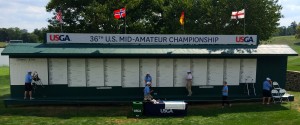Rules of Golf issues kept popping up at U.S. Mid-Amateur
November 18, 2016

The massive scoreboard for the 2016 U.S. Mid-Amateur at Stonewall Golf Club, Elverson, PA.
I traveled north to Elverson, PA for the 36th annual U.S. Mid-Amateur Championship, held Sept. 10-16 at Stonewall. The 36-hole property features two courses designed by Tom Doak, who produced two unique layouts on the sprawling, hilly acreage.
The tournament format called for two days of medal play among the more than 260 qualifiers, with a cut to the top 64 for several rounds of match play. The 36-hole final would also use both courses.
For the first day, I followed 2015 U.S. Senior Amateur Champion Chip Lutz, of nearby Reading, PA. He appreciated the fact that he only had a 30-minute ride to Stonewall, compared to far longer treks in past tournaments. Mid-Am first-timers Ryan Gale of Costa Mesa, CA, and Colton Knedler of Scottsdale, AZ, completed his group.
Playing in hot and muggy conditions, the three golfers began on the Old Course, which averaged 2 strokes harder per round than the North Course during the weekend. They also encountered several Rules situations in that round.
On the second hole, an uphill 427-yard par 4, Lutz’s drive left him 166 yards for his approach from the fairway. Knedler’s drive landed within a foot of Lutz’s ball–effectively stymied by a Titleist.
The two men chatted briefly, and, using Rule 22-2, Lutz lifted his ball from the fairway, replacing it when Knedler finished his second shot. Both missed the green, however, and both made bogeys.
On the sixth hole, a sharply downhill 435-yard par 4, Lutz hit a great approach from the right rough 123 yards out, to 18 feet left of the hole. Gale’s second shot from the fairway 115 yards away rolled up and smacked Lutz’s ball on the green, shoving it a couple feet closer to the hole.
I was standing next to the green as it happened, told Gale and Lutz about it as they came up, and told Lutz where to return his ball to its original resting place. Gale’s ball ended up next to Lutz’s original spot and a little beyond, so Lutz also gained a little additional help when Gale putted first. This situation and its resolution are addressed in Rule 19-1 (for Lutz’s ball) and Rule 19-5 (for Gale). Both players made par.
Gale faced another Rules situation on the next hole, a 160-yard par 3 with the wind coming into the players’ faces from the right. The Californian’s approach was knocked down by a strong gust, plugging his ball into the sandy face of the bunker in front of the green.
The ball not only buried in the sand, but also covered itself completely. Gale and Lutz first thought the ball was in one spot, but after some careful digging Gale failed to find it. Then they looked a few feet further left. Brushing gently, Gale found a ball, but still needed to scratch away more sand until he could confirm it was his.
The discussion then centered on how to restore the sand to its “original condition” for Gale’s next shot. They called for a USGA Rules official, and David Fite soon appeared. As he said, “Put the sand back, but leave about a quarter-inch of ball visible. You’re entitled to see it.”
Rule 12-1a.’s terminology is a bit more formal:
“If the player’s ball … is believed to be covered by sand, to the extent that he cannot find or identify it, he may, without penalty, touch or remove the sand…. If … found, the player must re-create the lie as nearly as possible…. In re-creating a lie …, the player is permitted to leave a small part of the ball visible.”
Gale followed the Rules, left himself something to stare at, and took a big swing that lifted his ball onto the green, 45 feet from the hole. He two-putted from there, a good bogey under the circumstances.
On the 442-yard par-4 10th hole, Knedler’s drive finished in the right rough, 187 yards from the center of the green. It also rested in the middle of a sod seam separating two sections of browned-out turf, with a small bit of green grass just to one side. He stared at it for a while, then picked a club and made his shot. It nicked a tree branch and landed in the right rough about 25 yards from the hole. His pitch from there finished ten feet from the hole, and he two-putted for bogey.
After the round, I asked him about the sod seam. Knedler said he knew that the Notice to Players Sheet mentioned the possibility of potential relief, but he liked the lie better than his likely options if he moved it off the seam. He also blamed that bit of green grass for causing his next shot to go further right than he planned, but otherwise was fine with his tactical choice.
For Seams of Cut Turf, the Notice to Players said, “Local Rule as prescribed in Appendix 1 is in effect.” The recommended Local Rule text allows golfers to take relief if the ball “lies in or touches the seam or the seam interferes with the area of the intended swing.”
However, Knedler was not required to take relief from that seam. He made his choice and accepted the consequences.
Frankly, I was impressed that Knedler read the Notice to Players Sheet before the round. Others have not and paid the price, the most notable being Dustin Johnson during the 2010 PGA Championship at Whistling Straits.
Johnson didn’t read the Notice for that competition, and mistakenly assumed he was hitting from a sandy waste area on the 18th hole. The Notice warned all who read it that any bunker had to be treated as such, and not as a waste area. Johnson’s failure to read it cost him the Championship.

